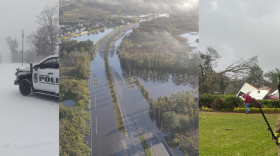World War II veterans from the U.S., Britain and Canada are joining 25 heads of state and many others on the beaches of Normandy today to commemorate the 80th anniversary of D-Day.
Here’s what to know:
- 2024 events: Hundreds of UK Armed Forces personnel will parachute into a historic D-Day drop zone, and a candle-lit vigil will be held at Bayeux War Cemetery, where 4,600 graves of World War II military victims will be illuminated. England’s King Charles III and U.S. President Joe Biden are among those expected to attend.
- How the day unfolded: The Allied invasion of Nazi-occupied France was unprecedented in scale and audacity, using the largest-ever armada of ships, troops, planes and vehicles to change the course of World War II.
- Veterans share their memories: Few witnesses remain who remember the Allied assault. The Associated Press spoke to veterans about what messages they have for younger generations.
Veterans of World War II, many of them centenarians and likely returning to France for one last time, pilgrimaged Tuesday to what was the bloodiest of five Allied landing beaches on June 6, 1944. They remembered fallen friends. They relived horrors they experienced in combat. They blessed their good fortune for surviving. And they mourned those who paid the ultimate price.
Under their feet, the sands of Omaha Beach, and in their rheumy eyes, tears that inevitably flowed from being on the revered shoreline in Normandy, France, where so many American young men were cut down 80 years ago on D-Day.
They also bore a message for generations behind them, who owe them so much: Don’t forget what we did.
“They probably wouldn’t be here if we hadn’t be successful,” said Llilburn “Bill” Wall, who flew bombers in WWII and will celebrate his 101st birthday this week as world leaders gather in France to pay homage to the D-Day generation.

As decades pass, D-Day anniversaries in Normandy have become increasingly fun-fair like, clogging the region’s leafy roads with WWII-era fans dressed in the uniforms and driving restored vehicles of the time. But the presence of an ever-dwindling number of veterans keeps the commemorations real, inevitably raising questions about whether the memories, pathos and lessons of WWII will fade when they are gone.
“There are things worth fighting for. Although I wish there was another way to do it than to try to kill each other. But sometimes you’re called upon to do something and you just do it. You know? That’s it. These people looked death in the face and just kept right on coming,” said Walter Stitt, who turns 100 in July and fought in tanks — surviving the destruction of three.
“There are things worth fighting for. Although I wish there was another way to do it than to try to kill each other. But sometimes you’re called upon to do something and you just do it. You know? That’s it. These people looked death in the face and just kept right on coming.”WWII veteran Walter Stitt, who turns 100 in July and fought in tanks — surviving the destruction of three
“All those young men that never had a chance to go home and find a love of their life and hold their children in their arms,” he said on Omaha, wiping away a tear.
On the bluffs above Omaha, at the Normandy American Cemetery with 9,387 immaculately tended graves, 100-year-old Bob Gibson paid tribute to comrades who fell on D-Day, when he landed on the other, less-bloody American landing beach, code-named Utah.
“You don’t want other people to go through the same thing,” he said. “Because I’ve seen a lot of these boys that never even made the beach, believe me. And we were all 18, 19 years old.”
“I’m glad I made it. The old boy upstairs took care of me,” he said, gesturing skyward.
Across the Normandy coast where the largest-ever land, sea and air armada punctured Adolf Hitler’s defenses in western Europe on D-Day and helped precipitate his downfall 11 months later, Allied veterans are the VVIPs of this week’s 80th anniversary celebrations.

More veterans were on their way Tuesday, traveling by ferry from southern England across the English Channel that 23,000 Allied airborne troops flew over to drop on D-Day into Normandy and which more than 132,000 others crossed aboard thousands of ships that stretched as far as eyes could see, landing on Utah and Omaha and three other code-named beaches: Gold, Juno and Sword.
“It looked like you could walk across the Channel using boats as stepping stones,” recalled 100-year-old Robert Pedigo, who was a nose gunner aboard a B-24 bomber that flew over the landing beaches on D-Day to pound German forces from the air. He was part of the veteran group that visited Omaha on Tuesday, brought to France for the 80th anniversary by American Airlines.
Back at base on D-Day night, he was told the Allies had suffered thousands of casualties.
“Overwhelming,” he recalled. Although his bombing mission that day proved to be among the “easiest” of 30 he flew over occupied France and Nazi Germany, “the emotional impact was the greatest.”
More than 4,400 Allied troops were killed on D-Day, including more than 2,500 Americans. The Allied toll grew appallingly in the Battle of Normandy that ensued, with 73,000 killed and 153,000 wounded.
Eight decades on, veterans are making more pleasant new memories to go with painful old ones.
Aboard the Mont St. Michel ferry carrying them Tuesday to France, about 20 British veterans gathered on deck and waved like rockstars to well-wishers who cheered them off.
A pipe band struck up a stirring rendition of “Brave Scotland.” Sailors stood at attention. Fireboats blasted their hoses in an arc. A military transport plane flew past twice.
RAF veteran Bernard Morgan, who worked in communications on D-Day, chuckled: “It was more pleasant coming today than it was 80 years ago.”
King Charles III pays tribute to veterans at British Normandy Memorial
King Charles III and Queen Camilla have led commemorations at the new British Normandy Memorial in Ver-sur-Mer.
Camilla wiped away a tear as actor Martin Freeman read words by 99-year-old D-Day veteran Joe Mines, recalling that “I was 19 when I landed, but I was still a boy. I don’t care what people say, I wasn’t a man, I was a boy. And I didn’t have any idea of war of war and killing.”
Welsh singer Tom Jones, 83, sang his song “I Won’t Crumble With You If You Fall,” before the king addressed the audience in French and English.
Charles said that while the number of living veterans was dwindling, “our obligation to remember what they stood for and what they achieved for us all can never diminish.”
Speaking in French, Charles paid tribute to the “unimaginable number” of French civilians killed in the battle for Normandy, and the bravery and sacrifice of the French Resistance.
Imagining the horror and celebrating freedom
Because freedom is worth celebrating and passing on to children, too, Alexandra Hamon, 35, drank champagne and shared the sunrise with her boys, Karl and Neils, both 13, as the day dawned Thursday over the beaches where Allied soldiers landed on D-Day.
The family was among a crowd several thousands strong that stretched for kilometers along Utah beach — one of the five beaches along the coast of Normandy where Allied troops landed. Utah and Omaha were taken — at the cost of hundreds of lives — by American forces, with the others stormed by troops from Britain and Canada, also killing many hundreds, plus others from France. The other code-named beaches are Juno, Sword and Gold.
Karl sat perched on the hood of their 1943 Dodge truck, lovingly restored by her husband, Enogat, as the family from Saint Malo, a French coastal city that was badly damaged in major fighting about two months after D-Day, stared out across the English Channel.
The waters Thursday were still and peaceful — unlike on that fateful day that helped change the course of WWII and precipitate Adolf Hitler’s downfall 11 months later.
“It’s indescribable, just imagining the chaos. Now it’s peaceful, almost festive, we try to imagine but I think it’s unimaginable,” she said.
“You think of all those guys, everything they went through,” she added of the fast-dwindling D-Day veterans. “They say they aren’t heroes. But they are, they are. Those guys really should never die. I imagine the boats, the guys arriving, the sounds. It must have been horrible, yes, horrible.”

Keeping alive the memory of soldiers ‘who died for our freedom’
UTAH BEACH, France — As the rising sun took the night’s chill off Utah Beach, Christophe Receveur, 57, from Thionville in eastern France, unfurled a Stars and Stripes he bought in Gettysburg, PA, six months ago specifically to honor the Americans who fell on D-Day.
“To keep alive the memory of the soldiers who died for our freedom,” he said. “To forget them is to let them die all over again.”
Receveur and his daughter, Julie, 28, carefully folded the flag into a tight triangle after their quiet, reflective homage on an empty stretch of the beach, busy with hundreds of people strung out along the sands.
Receveur said the Ukraine war was on his mind, too, as he honored the fallen of WWII. His great grandfather fought in WWI, his grandfather was a prisoner of war in WWII, and his father was a veteran of France’s war in former North African colony Algeria.
“I don’t want our freedom, for our kids, our grandkids, to be hit by … I don’t want to say a madman,” referring to Russian President Vladimir Putin. “So a lot of respect for these people who died and for those who are still dying,” he said of the WWII dead and those in Ukraine.
He said the D-Day sacrifices have to be remembered. “Lots of emotion that all these troops came to liberate a country that they didn’t know for an ideology — democracy, freedom — that is under severe strain now.”







